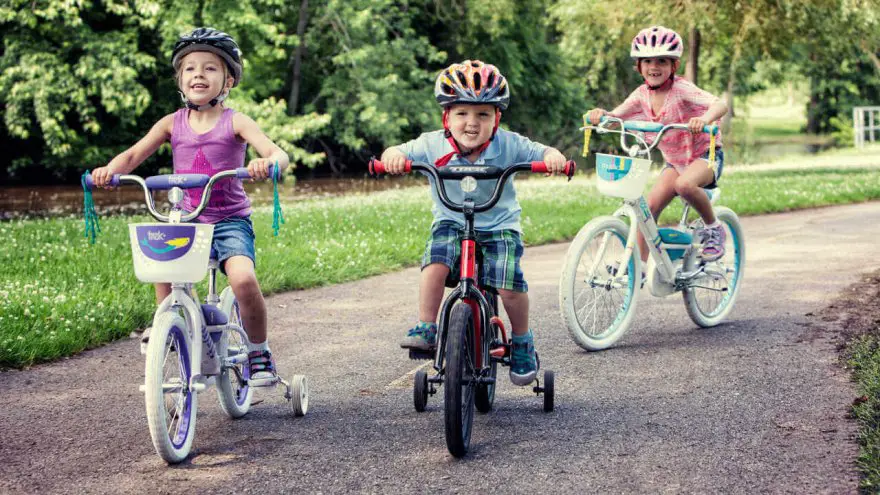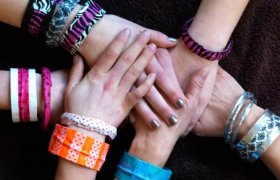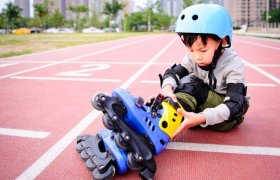Teaching Your Kid How to Ride a Bike

The saying goes that “once you learn how to ride a bike, you never forget.” Well, if you never forget how ride a bike, that means you might have forgotten that you even had to learn how to ride a bike to begin with. It’s not that you’ve forgotten that at one point you did not know how to ride a bike, you may just not remember exactly how it is that you learned to do so.
Even though it seems like second nature now, when you think back to when you couldn’t ride, you might be wondering “how exactly did I learn how to do something that I now do without even giving it a second thought?” If you’re deeply contemplating on the experience of how you yourself learned how to ride a bicycle, then it’s pretty likely that you’re now in the position where you have to teach someone else how to ride. Yep, it’s time to teach your kid how to ride a bike—and even though you’ve never forgotten how to ride, you now have to remember how it is that you learned.
If your saying to yourself “Well, seeing as how I haven’t forgotten how to ride a bike, learning to ride one couldn’t have been that hard could it?” Luckily, the answer to that question is “yes”—it’s not that hard to learn how to ride a bike or teach your kid how to ride one—meaning you shouldn’t have too much trouble teaching your child. It’s not going to necessarily be a walk in the park (or even a super smooth ride through the park—not at first), but as a parent, you’ve probably faced much more difficult tasks. Your child might be a little intimidated by the idea of riding a bicycle on her own at first (at least without training wheels), but with your patience and guidance she’ll be feeling confident about hopping on that bike and riding it all on her own in no time.
Learning environment
When teaching your kid how to ride a bike, it’s important that you a pick a location where your child feels comfortable learning. Simply put, you’re not teaching your kid how to go mountain biking, so look for a space that’s wide open and fairly flat. An empty parking lot, school blacktop, tennis court, or basketball court are all great places to start. If you have a large enough driveway, that’s a great spot too.
Safety first
This one may go without saying, but you have to teach your kid the proper safety precautions and methods before you even begin your lesson. If your kid is already familiar with riding with training wheels, she’s probably already familiar with helmet, and elbow and knee pad safety. If not, now’s the time to show how her how to properly get geared up for a bike ride. And of course, since you’ll probably be using a separate bike of your own to give your child tips, you’re going to need to wear all the proper safety gear as well so that you set a good example.
Begin with balance

Before your kid even gets moving, you’re going to have to teach her how to properly balance herself on a bicycle. This means you’ll need to strip down the bike a bit—meaning you’ll have to remove training wheels and also remove the pedals (you can do this with a pedal wrench). Next, just lower the seat, have her sit upright with her hands on the handle bars, and you’re ready to show your kid how to maintain balance on her bike.
To get your kid to really understand balancing the bike, just have her lightly and slowly scoot her feet around on the ground. Once she gets used to the idea of staying properly balanced on the bike, you can work on getting her to coast so that she actually gets used to moving a bit more quickly and almost automatically, so to say.
When teaching your kid to coast, simply have her stretch her legs out while she remains on the seat. You can gently push her to give her a little momentum, or even just stay close behind her or even next to her with your hand on her shoulder. Just guide her a bit to get her going; she’ll probably only be coasting for a few seconds at a time once you let her go, but as she becomes more comfortable with you giving her a little more momentum and then letting her coast on her own a bit, she’ll be able to coast a little easier, go a bit further in distance, and understand how it feels to go just a little bit faster.
Steering the bike
Once you’ve given your kid the basics of staying balanced while in motion, it’s time to teach her to take a little bit more control and learn how to steer her bicycle. At first you can get her to slowly scoot and coast in a circular motion just to give her a feel for what it’s like to go beyond just moving in a straight line. It’s definitely best to have her scoot and steer before you have her coast and steer.
There are many who suggest scooting exercises or games. You can do something like set up some cones and have your kid maneuver her way around the cones. When you start with having her scoot around the cones, she’ll basically memorize the way she’s supposed to be moving if you have her do it enough times before moving on to coasting.
By the time she’s ready to coast, your kid will already be familiar with what you might call the course, and coasting won’t be as difficult since she knows what to expect as far as twists and turns. Once you (and of course your kid) feel confident in her ability to handle the basic movements of the bike, it’s time to get started with the process of teaching her how to use the pedals.
Pedaling the bike
This part might sound a little scary, but if you’ve properly prepared your child and you’re able to provide to her the proper physical (and emotional) support needed, then teaching her how to pedal shouldn’t be that much of a problem. You’ll want to begin the process in a similar vein as you did with the prior scooting method.
Just have your kid sit upright on the seat while she keeps one foot flat on the ground and her other foot on the pedal raised up a bit. Have your child push off with her foot on the ground (tell her to do it just as if she were scooting), and have her move her other foot forward on the pedal. She’ll already understand how to move the bike forward with her feet due to the scooting exercise, and when she pushes off with her foot that was originally on the ground, she’ll still (albeit briefly) be moving in a way that was similar to scooting; it’s not going to be as if moving the bike while simultaneously using her legs is a completely foreign idea.
When she begins to move forward and gains a bit of momentum, make sure your hand is kept gently on her back or shoulder while you guide her forward just as you did while helping her to keep her balance during the coasting phase. You’re going to be the one in control of her speed at this point—given whatever speed you decide on while guiding her—so make sure she feels comfortable with how fast or slow you’re going. Of course, you don’t want to push her too fast immediately, but if she tells you she’s ready to go a little faster just go ahead and give it a shot. If she feels uncomfortable with the speed, she’ll be sure to let you know. You can guide her by walking behind or next to her, or you can even very slowly ride next to her on your own bike.
Try guiding her for several minutes; that might seem like a long time but you have to remember that you’re basically teaching her to memorize motions and what those motions feel like—meaning she shouldn’t be thinking too hard about what she’s doing. If she’s not giving the idea that she’s moving a ton of thought, she won’t be as worried as to if she’s getting everything right. So, after some steady and consistent guidance, moving on her own shouldn’t feel that much different as if she were being guided by you, and she won’t be frantically trying to figure out what’s going; the idea is to familiarize her with the motions and movements and make her comfortable.
After you feel she’s pedaled with your guidance for the appropriate amount of time, just simply and slowly draw your hand away from her back or shoulder and let her ride. Give her a bit of a warning before you do it so as not to throw her off right away, but don’t hype it up too much; you don’t want her to get overly excited and nervous to the point where she might lose control due to the focus of impending and seemingly scary solo cycling. If you calmly say to her that you’re about to remove your hand from her back or shoulder—and you do so as softly as possible—she’s probably not even going to notice at first that you’re no longer supporting her.
Up to this point (at least in terms of moving straight forward), she’s already going to be used to the motion and understand what it she’s supposed to do. The scooting practice makes it so that she’s used to moving her feet, and the coasting practice allows her to feel more comfortable with how it feels to ride a bike without her feet on the ground.
Your kid most likely isn’t going to be able a ride a long distance at first without taking a little tumble, so even when she is able to ride off on her own, you want to make sure you’re still close behind in the event that she falls or looks like she’s about to fall if she appears too wobbly. And if she does fall or doesn’t feel totally confident right away, all you have to do is tell her it’s okay.
Pedaling and steering
You’re probably going to want to guide your child still when teaching her how to simultaneously pedal and steer. Even if she already feels comfortable and confident pedaling without your assistance, steering can still be kind of tough; so, at first you’ll still want to have your hand on her shoulder or back.
Again, steering won’t be a totally alien experience to your kid. She’s already steered while scooting and coasting (while also staying balanced), so this step isn’t going to be complete terrifying; it’s just a step that’s a little different and requires a bit more control.
For this step, you’ll want to either move in circles or use cones just as you did with the steering part of the learning experience. Just guide your child as you did while you were working on the pedaling process. You probably don’t have to guide her for the same time duration as did when originally working on pedaling—but that’s really up to you once you gauge your child’s confidence level. After you’ve gotten her used to the motion of moving beyond a straight line, just remove your hand and see how she does. Chances are, she’s going to be able to handle it just fine.
Using the breaks
Teaching your kid how to use the breaks is a pretty simple process. Again, you’ll need to do some more guiding, but this time it’ll be a bit different. What’s different is that you’ll be focused on keeping her from going backwards as opposed to moving her forward.
First, you’ll need to instruct her on how to use the break. In terms of getting her to stop without falling, just stay close behind her when she decides to stop, that way she has a steady support system in the event that she possibly falls. Given the fact that she already understands the basics of balance, she should be able to keep herself from moving her body too much in any one direction when she puts the bike to a halt.
Have your kid practice breaking several times with your hands behind her body before you feel she can break without you holding her. All you have to remember is to stay close behind without touching her once you feel you she can let go, and you’ll be there for her in case she tips herself over.
Keep it fun

Even though teaching your kid how to ride a bike isn’t all that hard, that doesn’t mean your kid is going to get it right away—and that’s just fine. If you’ve been at it for a while and she isn’t able to grasp the idea or simply doesn’t feel comfortable, then just step away and call it quits for the day. You can also try again the next day, or any other time she feels she’s ready to try.
You definitely don’t want to force it; riding a bike is fun and if you don’t make the learning experience enjoyable, she’s most likely going to develop some sort of negative association with bike riding—associations that might even be related to a fear of your own frustration regarding her inability to ride the bike right away. If your kid is afraid you’ll get upset while she tries to learn how to ride a bike, she won’t exactly have a strong inclination to try and learn given that prior learning experiences just ended in frustration—or maybe even a feeling of possible disappointment from you, and your kid’s own internalization of that disappointment.
Teaching your kid how to ride a bike can be a great experience. Riding bicycles is a lot of fun, and there certainly isn’t anything more special than bonding with your child—especially bonding by way of passing on knowledge or a skill to your child. If you go about it the right way and remember to provide the proper emotional support, your kid will one day probably love teaching her own child how to ride a bike just as much as you’ll enjoy teaching her.







